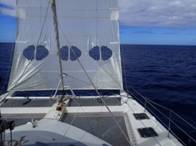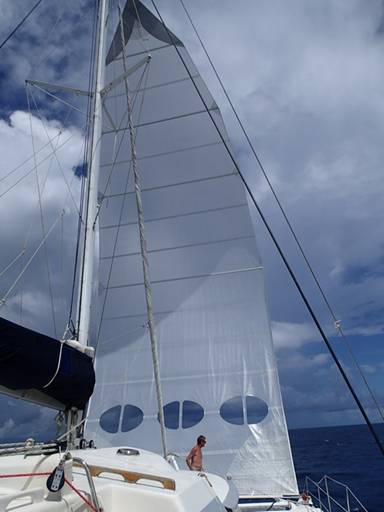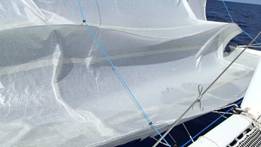
C'EST QUOI UN SPEEJONK ?
C'est une voile non endraillée, plus haute que large, comportant deux forts ronds de chutes tenus par des lattes horizontales.
Un Speejonk est une voile fantastique pour courir vent arrière avec un multicoque, rapidement et sans tracas.
Lien vers une vidéo de Speejonk en navigation
https://www.dropbox.com/s/f24deuv0wtc2x5y/SPEEJONK20141001.wmv?dl=0
Un Speejonk présente deux avantages majeurs :
• Il ne faseye jamais
• Son centre de voilure est situé haut ; ce qui induit qu'à puissance égale, il a moins de surface qu'une autre voile ; d'où avantage économique et gain de poids.
Un Speejonk permet de naviguer avec un multicoque en toute sécurité aux allures portantes .
Avec ses points d'amures fixes sur chaque étrave d'un catamaran, le Speejonk se porte à partir du vent arrière jusqu'à 125° du vent réel, sur chaque amure.
D'une surface égale à celle de la grand' voile et du génois additionnées, sa puissance propulsive s'approche de celle d'un spi, le confort d'utilisation et la sécurité en plus.
Grand' voile affalée et Speejonk haut, les manœuvres d'empannage n'existent carrément plus. Votre bateau suit son cap tout droit.
De 125° du vent tribord amure à 125° du vent bâbord amure, en passant par le plein vent arrière, il n'y a RIEN A REGLER !
Si le vent vient à augmenter considérablement, la surface de votre Speejonk peut être ajustée aisément.
Deux cas de figure peuvent se présenter :
• si vous avez opté pour un Speejonk monté sur enrouleur Facnor : rien de plus simple !
Il suffira de mollir la drisse, puis de reprendre la bosse d'enroulement pour ajuster la surface du Speejonk à la demande, sans quitter votre poste de barre, et ce, en quelques minutes seulement.
Lien vers une vidéo de Speejonk sur enrouleur Facnor :
https://www.dropbox.com/l/016rYEM2A2SZCMFOPeAqxh?text=1
• Si vous avez préféré la formule « Pleejonk », sans enrouleur, vous réduirez par prise de ris, en choquant la drisse et en reprenant la bosse de bretelles, lesquelles sont solidaires des lattes par un jeu d'anneaux de friction.
Simplement, cette manœuvre étant un peu moins rapide que dans le cas d'un enrouleur, vous devrez, en bon marin, anticiper en démarrant la manœuvre de réduction AVANT l'arrivée du grain…..

Affalage du Pleejonk à bord de Catafjord
HISTORIQUE :
Printemps 2012, derrière la grande barrière de corail ;
Catafjord, robuste catamaran de 64', mené depuis quatre ans par Malou et Dominique MONTESINOS, progresse toujours vers l'Ouest, à dessein de boucler une circumnavigation de préretraite, planifiée de longue date.
Catafjord n'est équipé d'aucune voile de portant ; ni spi, ni gennaker.
Hors, lors d'un tour du monde par les alizés, du portant, on en fait beaucoup.
Catafjord étant un bateau plutôt rapide, avec de nombreuses journées à plus de 220 milles en traversées, les allures très « arrivées » constituent son talon d'Achille.
Ça chagrine beaucoup Dominique, qui bénéficie d'une grande expérience en construction nautique, et d'une autre, plus limitée, en course au large.
Aussi, à force de réflexions, durant les longs quarts de vent arrière, de nuit comme de jour (à bord de Catafjord, on veille en permanence), l'idée de cette voile semi-elliptique, aux « épaules » tenues par des lattes, s'est imposée comme une évidence.
Juillet 2012 ;
Une maquette sommaire est construite lors d'une escale en Indonésie, avec des morceaux de polystyrène (du genre de ceux qui jonchent les plages du monde entier, hélas), et testée, avec un succès immédiat. Dès ce stade primitif, les avantages de l'invention s'avèrent éclatants.
ACTUALITES :
Deux années s'écouleront, avant qu'un mécène ne finance le prototype à l'échelle 1, qui sera finalement mis au point dans les eaux Guadeloupéennes au cours de l'été 2014, avec Catafjord.
Merci Patrick, pour ce coup de pouce décisif.
Depuis la mise au point technique du Speejonk à enrouleur, par son inventeur, Dominique Montésinos, plusieurs étapes ont étés franchies.
En particulier, la conclusion d'un contrat avec la société Facnor, important fabricant d'accastillage, qui pourrait devenir, à terme, propriétaire de l'invention.
FACNOR a conçu un enrouleur spécifique pour Speejonk, ainsi qu'un système de fixation pour faciliter l'implantation sur la plupart des catas du marché.
Un prototype « industriel », monté sur une unité de 41', fonctionne correctement depuis plusieurs mois.
La commercialisation débutera au printemps 2016 ; plusieurs acteurs majeurs du marché ont déjà manifesté leur intérêt.
Parallèlement, l'inventeur a travaillé à la mise au point de la version « à bretelles », dépourvue d'enrouleur, et appellée « Pleejonk », plus économique et plus simple à installer.
COMMENT EQUIPER VOTRE BATEAU ?
En attendant que le Speejonk figure dans la liste des options de votre constructeur préféré, une étude personnalisée d'implantation et de coût peut vous être fournie en faisant simplement la demande
Informations nécessaires :
• Type de bateau
• Longueur
• Largeur
• Poids
• Distance entre l'ancrage d'étai et la sortie de drisse de spi
• Distance entre les étraves
• Port d'attache
• Comment vous joindre ?
CONSEILS D'UTILISATION :
Avant d'établir votre Speejonk, assurez-vous d'avoir suffisamment d'eau à courir.
Le Speejonk est une voile puissante, et, si le vent a fraichi, plusieurs minutes peuvent être nécessaires pour le rentrer…..pendant ce temps, votre bateau filera bon train.
A l'approche d'un obstacle, anticipez largement la manœuvre de rentrée de votre Speejonk.
Amenez le bateau plein vent arrière, et commencez par filer une bonne longueur de drisse (sans toutefois laisser la voile toucher l'eau) ; ainsi, les efforts nécessaires pour amener la voile seront moindres.
En navigation, n'approchez pas trop près de la limite des 125°, car, lors d'une saute de vent, votre Speejonk pourrait se trouver pris à contre, et stopper le bateau.
Ceci dit, si cette mésaventure devait vous arriver, le Speejonk étant situé très en avant, il fera rapidement abattre votre bateau, et les choses rentreront d'elles-mêmes dans l'ordre, mais vous risqueriez d'endommager les lattes.
CONTACTS :
« SPEEJONK », WHAT IS THAT?

It is a without-stay sail, higher than wide, with two large shoulders held by horizontal battens.
A Speejonk is fantastic to sail fast and quietly downwind with a multihull.
Link to a video of Speejonk in navigation
https://www.dropbox.com/s/f24deuv0wtc2x5y/SPEEJONK20141001.wmv?DL=0
A Speejonk has two major advantages:
- He never flutter
- Its wing centre is high situated; which leads to equal power, it has less area than other sail; giving advantage economic and weight gain.
A Speejonk allows sailing with a multihull safely in the downwind conditions .
With its tack clews fixed on each bow of a catamaran, the Speejonk goes from 125 ° of the real wind, a tack to another.
With a surface area equal to that of the main sail and the genoa added, its propelling power approaches that of a spinnaker, usability and security more.
Mainsail lowered and high Speejonk, jibe ship handlings disappears. Your boat steers its very right course all the time.
From 125° of the wind starboard to 125°of the wind port, via the full back wind, it does have NOTHING there TO REGULATE! Nothing to do, nothing to adjust. Just « let's go! »
If the wind comes suddenly to increase considerably, the surface of your Speejonk can be adjusted easily.
Consider two cases of figure:
-If you have opted for a Speejonk mounted on special Facnor furler: nothing simpler!
Simply check the halyard, and then heave haul on the furling sheet to adjust the Speejonk to the right surface, without leaving your steering position, and this, in just a few minutes.
Link to a video of Speejonk on Facnor furler at sea:
https://www.dropbox.com/l/016rYEM2A2SZCMFOPeAqxh?text=1
PLEEJONK:
- If you have preferred the “Pleejonk”, which is a Speejonk without furler, you will reduce by taking reefs. You have first, to release the halyard, and then haul on the “sling sheet” with a winch”, until the reefs points are at the deck.
Simple, also, but a little harder and longer.
This operation being a little slower than in the case of a Facnor furler, you will have, as a good sailor, to anticipate by starting the ship handling of reduction BEFORE the arrival of the squall .....

Pleejonk being lowered on Catafjord
HISTORY:
Spring 2012, behind the Great Barrier Reef;
Catafjord, robust 64' catamaran, managed since four years by Malou and Dominique MONTESINOS, is still progressing westward, on purpose to complete a circumnavigation of early retirement, planned for a long time.
Catafjord is equipped with no specific downwind sails; no Spinnaker, nor gennaker, only the basic sails.
Off, during a tour of the world by the trade winds, of downwind, it is many.
Catafjord is a rather fast boat with numerous days at more than 220 miles in crossings oceans; the winds astern constitute its “Achilles heel”.
It hurts much Dominique, who has a great experience in boat building, boat driving, and another, more limited, in racing off the coast.
Also, through reflections, during the long watch downwind, nights like day (aboard Catafjord, one takes care permanently), the idea of this semi-elliptical wing, with the 'shoulders' held by battens, has emerged as obvious.
July 2012;
A basic model is built at the time of a stop-over in Indonesia, with pieces of polystyrene (like those which strew the beaches in the whole world, alas), and is tested, with an immediate success. As of this primitive stage, the advantages of the invention prove to be bright.
Two years will run out, before a patron finances the prototype on the scale 1, which will be finally developed in Guadeloupe during the summer 2014, with Catafjord.
Thank you Patrick, for your decisive help in the right direction.
NEWS:
Since the technical development of the furling Speejonk, by its inventor, Dominique Montésinos, several steps have been completed.
In particular, the concluding of a contract with Facnor, leading manufacturer of fittings, who may ultimately become owner of the invention.
FACNOR has designed a specific furler for Speejonk, as well as an attachment unit to allow easy mounting on most catamarans of the market.
An "industrial" prototype, mounted on a 41' unit, is currently working properly.
Marketing is beginning on spring 2016; several major boat builders in the market have already expressed their interest.
At the same time, the inventor has worked on the “Pleejonk” version, witout furler (but economical and easier to install).
HOW EQUIP YOUR BOAT?
While waiting for that Speejonk appears in the list of the options of your preferred manufacturer, a personalized study of establishment and cost can be provided by simply making the request using the form attached :
- Name
- Type of vessel
- Length
- Width
- Weight
- Distance between the anchoring of stay chainplate and the spinnaker halyard exit
- Distance between the bows
- Homeport
- How to contact you?
OPERATING TIPS:
Before establishing your Speejonk, you ensure to have sufficient water to run.
Speejonk is a powerful sail, and, if the wind got stronger, several minutes can be necessary to decrease it during this time, your boat will spin good progress.
With the approach of an obstacle, largely anticipate the operation of re-entry of your Speejonk.
Move the boat full wind back, and start by spinning a large length of halyard (without however allow the sail to touch water); Thus, the required efforts to bring the sail will be lower.
In navigation, do not approach too much close to the limit of the 125°, because, during a wind shift, your Speejonk could be aback, and stop the boat.
That said, if this mishap should happen to you, the Speejonk being located well forward, it will quickly fall off your boat, and things will return to themselves in order, but you may damage the battens.
Contacts:
.